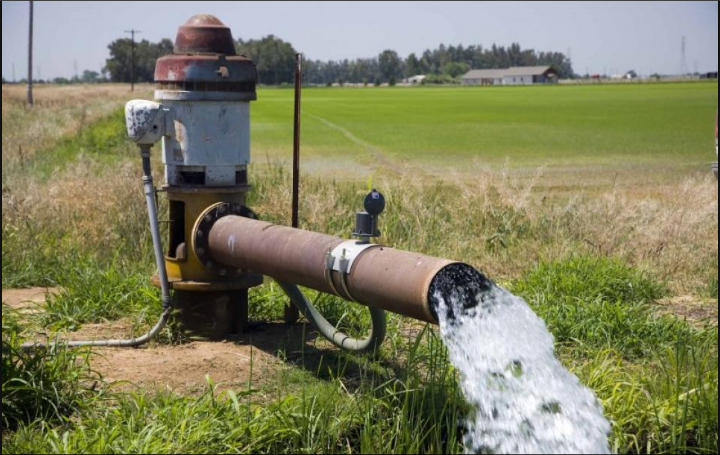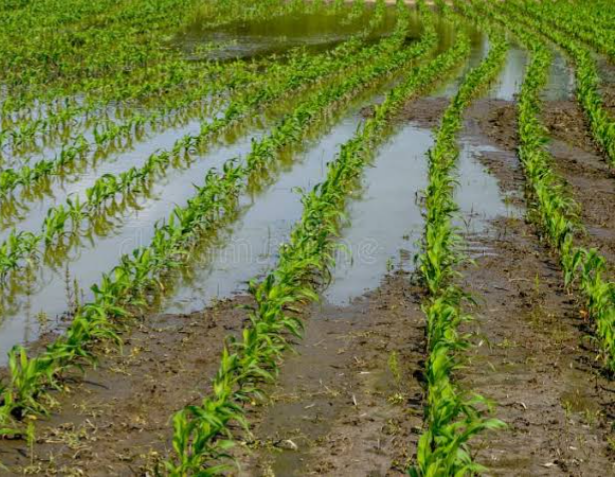
A lot of farmers are faced with the challenges of how to manage the water on their field. Water on field can be from rain water, irrigation, flooding and even rise in water table etc. This water, when it gets to the ground, it is constantly moving all the time. It is always moving, whether it can be seen moving or not, it keeps moving. It can move when it leads to erosion, leach nutrients down the profile, rise in water table, form pool on the soil surface etc. When rain falls heavily or over irrigation is done, water may saturated the soil. The water flowing from the saturated soil downward to deeper layers, feeds the groundwater reservoir. As a result, the groundwater level (often called groundwater table or simply water table) rises. If the heavy rainfall or continuous over-irrigation continues, the groundwater table will also continue to rise and may reach and saturate part of the rootzone, thus, damaging the plant.
Also, the water saturation may affect other agricultural activities. The oxygen which ought to be available to improve soil ecology is expelled causing an anaerobic soil condition. It also affect soil health. Therefore, to keep the soil community healthy, there is need for proper removal of water that saturated the soil to get optimum yield. At thesame time it should be noted that more yield also need more water. The only way to remove the excess water is through drainage.
Excess water may be caused by heavy rainfall, over- irrigation, canal seepage and flooding.
Drainage can remove excess water from an area before it enters the soil or reduce the water at the subsurface ground caused by rise in water table.
By definition, Drainage in agriculture is the artificial removal of water from land. Drainage water can be surface water or subsurface water.
TYPES OF DRAINAGE WATER
1. Surface water : Water above the ground
2. Subsurface water: Water below the soil surface.
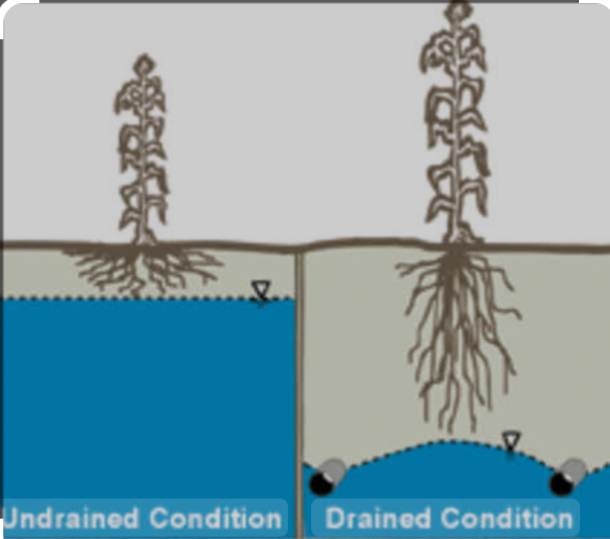
TYPES OF DRAINAGE
There are two types of drainage:
1. Natural drainage
2. Artificial drainage
1. NATURAL DRAINAGE : Many areas have some natural drainage, that is, the excess water in the soil flows from the field to swamps or to lakes and rivers. Water can move in the soil when it infiltrate deep down the soil profile. As the water infiltrate vertically down the horizons and meet an impermiable layer, the water will move sideways and reappear on the ground surface in the form of spring. This is an example of natural drainage. It does occur near hillsides.
Natural drainage, however, is often inadequate, thus, artificial or man-made drainage is required.
2. ARTIFICIAL DRAINAGE : This is a drainage type induced by man inorder to cultivate the land or dry out swampy lands.
Artificial drainage can either be surface drainage or subsurface drainage. When drainage is being discussed, it is not the surface drainage that is usually mentioned but mostly the subsurface drainage.
SIGNS OF POOR SOIL DRAINAGE
1. Water ponding on soil surface
2. Weeds such as sledges and rushes are commonly found in wet soils
3. Soil erosion and soil deposites
4. Soil colour changes to grey colour. This is a sign of poorly aerated soil especially oxygen depleted soils.
5. Shallow rooting of plants.
EFFECT OF POOR DRAINAGE
Poor drainage leads to:
1. MORE SOIL COMPACTION : When farm machines move on waterlogged soils, they compact the soil.
2. MORE SALT IN THE SOIL : In very dry areas there is often accumulation of salts in the soil. Most crops do not grow well on salty soil. Salts can be washed out by percolating irrigation water through the rootzone of the crops. To achieve sufficient percolation, farmers will apply more water to the field than the crops need. But the salty percolation water will cause the water table to rise. Drainage to control the water table, therefore, also serves to control the salinity of the soil
3. More diseases
4. FEWER SOIL MICROBS : Without oxygen in the soil, microbs will die off or reduce in the soil. Saturation of soil by water leads to all pore spaces in the soil to be filled with water and no room for air.
5. PLANT SURVIVAL: Plant roots require air as well as water and most plants cannot withstand saturated soil for long periods except hydrophytic plants like swaml rice.
SOLUTIONS TO DRAINAGE PROBLEMS
Certain factors are used to determine the most efficient drainage system design for a particular property or agricultural practice. Such factors include: soil type, land configuration or topography , amount and pattern of rainfall, and types of crops to be grown.
SOIL TYPE: This is the most important factor that determines drainage system to employ. It determines whether water will move through the soil rapidly or not. Soils that have a high percentage of sand- and silt-size particles and a low percentage of clay-size particles usually will transmit water rapidly through the soil because the particle size of the soil types ( sand) and this will make subsurface drainage feasible. Soils that are high in clay-size particles usually cannot be drained by subsurface improvements. In summary, soils of high sand or silt content are generally suited to subsurface drainage, while soils of high clay content generally require surface drainage systems.
TOPOGRAPHY : The topography or slope of the land is also an important factor that determine drainage system design . In many cases, land in need of drainage is flat. This type of topography is easy to apply drainage system compared to slopy land.
RAINFALL PATTERN: The rainfall patterns, the crops to be grown, and the normal height of the water table also are considered. If heavy rainfall does not occur during critical stages of crop growth, less extensive drainage improvements may be needed.
TYPES OF CROPS TO GROW: The capacity of the drainage system is governed in part by the growth pattern of the crop, its planting date, critical stages of growth, tolerance of excess water, harvest date, and value.
TYPES OF DRAINAGE SYSTEMS
Drainage systems may be divided into two categories:
1. surface drainage system and
2. subsurface drainage system
Both of them have several components but perform similar functions. They both have an outlet which is the point through which water is disposed off from the system. The outlet is emptied into natural stream or river or a large constructed ditch.
1. SURFACE DRAINAGE SYSTEM
A surface drainage system is employed to prevent surface water ponding and control runoff. It is used to remove water from the surface of the soil and to approximately the bottom of the field ditches also called shallow ditches or open drains. The shallow ditches discharge the water into larger and deeper collector drains. To facilitate easy flow of the excess water toward the drains, the field is given an artificial slope by means of land grading .
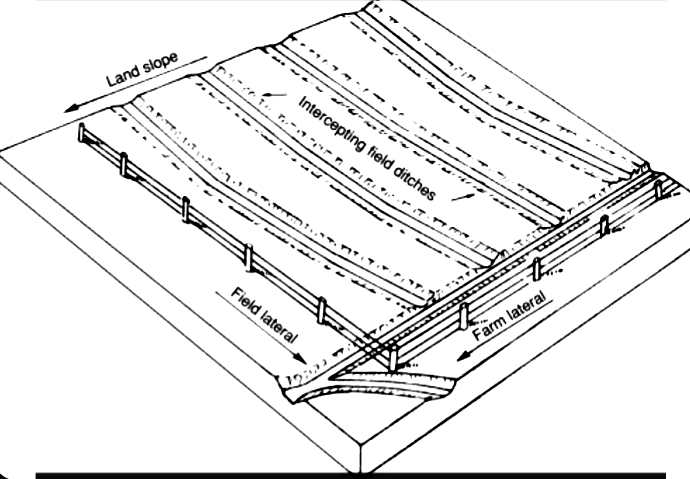
A surface system is the only means for drainage improvement on soils that absorb or transmit water slowly. Atimes, Individual surface drains may be used to supplement subsurface systems by removing water from ponded areas.
The components of a surface system are the main collection ditch, field ditch, and field drain.
Surface drainage is easier and cheaper to construct compared to subsurface drainage. Some of the disadvantages of surface drainage is that it ran cause gully erosion, leads to soil compaction, difficult mechanisation practices, it occupies land spaces which ought to be used for planting and it requires frequent maintenance.
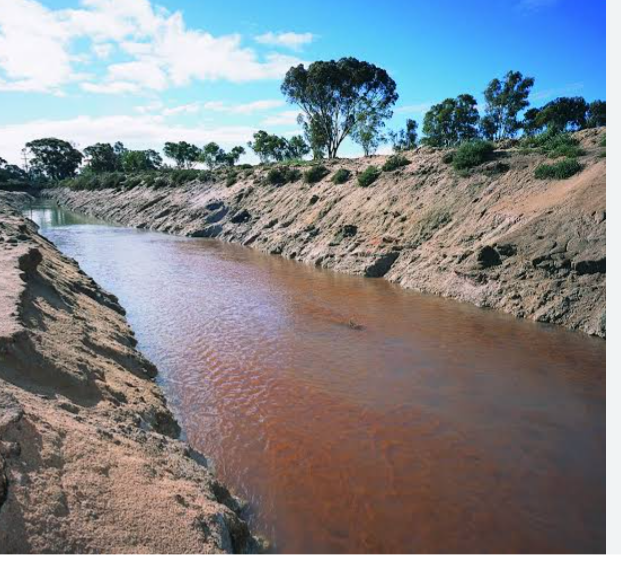
SOLUTIONS TO SURFACE DRAINAGE
i. Landscaping
ii. Ditching
iii. Move water faster by making potholes
iv. Use of French drains
v .Construct trenches etc.
2. SUBSURFACE DRAINAGE SYSTEM
The subsurface drainage system is also called a tile system. All the parts/components except the outlet are located below the surface of the ground. It provides better drainage than a surface system because it removes water from the soil to the depth of the drain, providing plants a greater mass of soil for root development, permitting the soil to warm up faster in the spring or wet season, and maintaining a better balance of bacterial action, the air in the soil, and other factors needed for maximum crop growth.
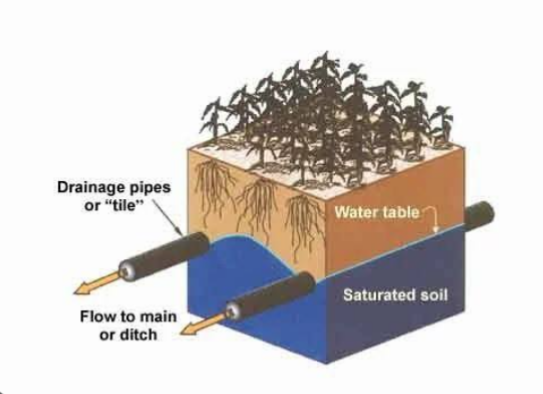
Subsurface drainage systems are commonly used in many irrigated areas to control the water table and ensure that water will be able to move through the soil, thus keeping salts from accumulating in the root zone and making the soil unproductive.
The components of a subsurface system are the main, submain, and lateral conduits from the submain.
FUNCTIONS OF THE SUBSURFACE COMPONENTS
THE MAIN : This component carries water to the outlet
THE SUBMAIN: It is also called the field ditch. It collects water from a number of smaller units and carries it to the main
THE FIELD DRAIN : It is also called the lateral. It is the smallest unit of the system and it removes the water from the soil.
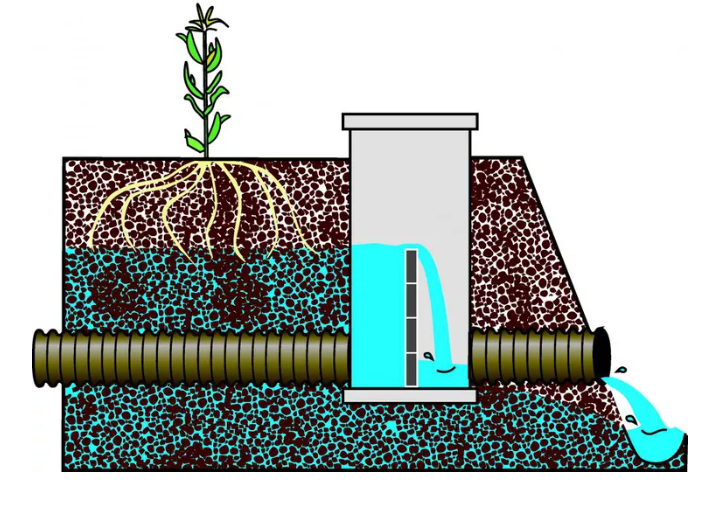
SOLUTIONS TO SUBSURFACE DRAINAGE
For water below the ground surface, drainage system is required. The main drainage system used is the drainage tiles..
Others Include :
a. deep open drains)
b. Mole drains
c. groundwater Pump
d. Pipe drains (Subsurface Tile Drains)
THE DEEP OPEN DRAINS : In deep open drains, deep trenches are dug on the field through which excess water from the rootzone flows into the open drains which may or may not terminate into a collector drain. The disadvantage of this type of subsurface drainage is that it makes the use of machinery difficult.
PIPE DRAINAGE: Pipe drains also called drainage tiles are buried pipes with openings /perforations through which the soil water can enter. The pipes convey the water to a collector drain. Drain pipes are made of clay, concrete or plastic. They are usually placed in trenches by machines. In clay and concrete pipes (usually 30 cm long and 5 – 10 cm in diameter) drainage water enters the pipes through the joints. Flexible plastic drains are much longer (up to 200 m) and the water enters through perforations distributed over the entire length of the pipe
A lot of people have misconception about drainage tiles. Some of the misconception include:
1. The tiles does not work totally due to rain.
2. Tiles does not take all the water off the ground.
Tiles only work when water table rises
MOLE DRAINAGE
Mole drains are used to remove water from heavy soil. They are mainly used for subsurface water drainage. It is made up from unlined channels dug out by a mole plough. The soil must have a high clay content to help the channel keep its open shape for many years.
There are different types of mole drains. The different types include:
a. Regular mole drains
b. Gravel mole drains
c. Mole drains over a collector pipe
d. French Drains (Trench Drain ).
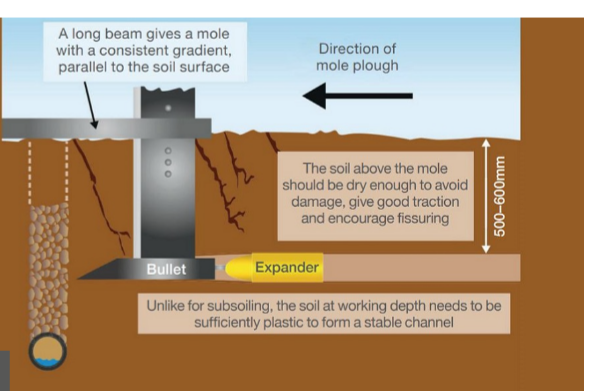
FRENCH DRAINS (TRENCH DRAIN )
French drains collect and remove water from areas that are highly saturated with water. It help prevent flooding effects and other problems caused by over watering. The system uses gravity to drain water from saturated sites.
It consists of a trench dug in the ground in which perforated pipe are laid, surrounded by gravel. The trench is then covered with soil. The soil performs the following functions: keep the gravel in place, help with the absorption of water and keep the drain hidden from the landscape.
Water easily seeps into the perforated pipe. The gravel filters out debris that might eventually cause the system to clog up.
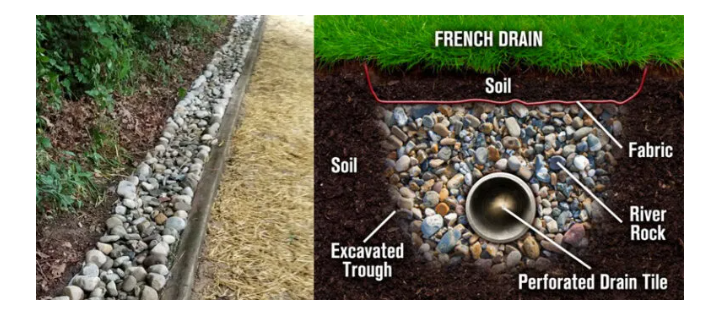
GROUNDWATER PUMP
A groundwater pump can be installed to reduce the water table or keep it at a workable level below ground. The pump’s effectiveness depends on the height of the water table, type of soil, and depth of the aquifer—the water-bearing geologic formation that gathers water. The pump is connected to a pipe placed in a well. As water increases in the well, the water is pumped out.
